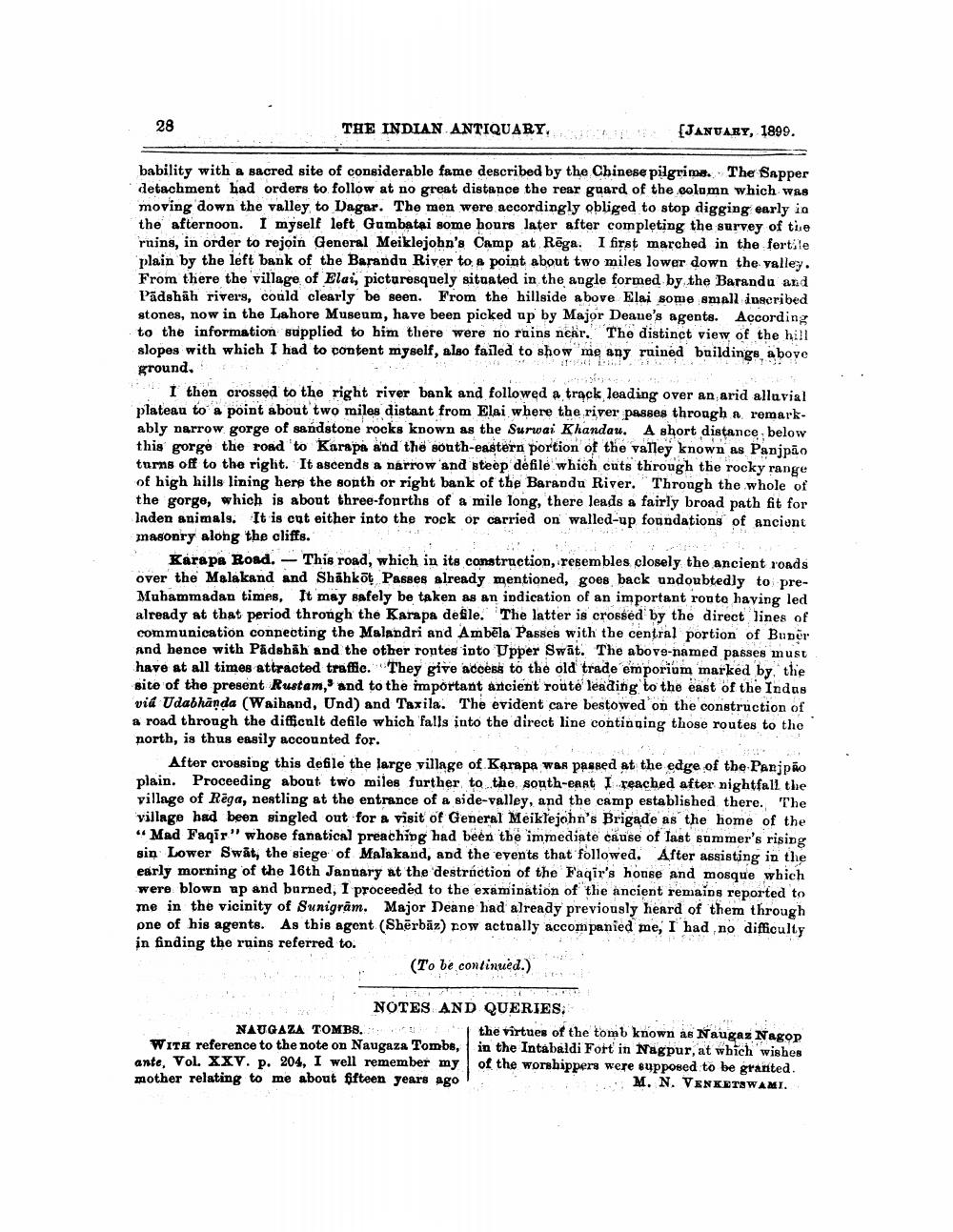________________ 28 THE INDIAN ANTIQUARY.. [JANUARY, 1899. bability with a sacred site of considerable fame described by the Chinese pilgrime. The Sapper detachment had orders to follow at no great distance the rear guard of the colomn which was moving down the valley, to Dagar. The men were accordingly obliged to stop digging early in the afternoon. I myself left Gumbatai some hours later after completing the survey of the ruins, in order to rejoin General Meiklejohn's Camp at Rega. I first marched in the fertile plain by the left bank of the Barando River to 8 point about two miles lower down the valley. From there the village of Elai, picturesquely situated in the angle formed by the Barandu and Padshah rivers, could clearly be seen. From the hillside above Elai some small ingeribed stones, now in the Lahore Museum, have been picked up by Major Deane's agents. According to the information supplied to him there were no ruins near. The distinct view of the hill slopes with which I had to content myself, also failed to show me any ruined buildings above ground, H. I then crossed to the right river bank and followed a track leading over an,arid allavial plateau to a point about two miles distant from Elai where the river passes through a remarkably narrow gorge of sandstone rocks known as the Surwai Khandau. A short distance below this gorge the road to Karapa and the south-eastern portion of the valley known as Panjpao turns off to the right. It ascends a narrow and steep defile which cuts through the rocky range of high hills lining here the south or right bank of the Barandu River." Through the whole of the gorge, which is about three-fourths of a mile long, there leads a fairly broad path fit for lnden animals. It is cut either into the rock or carried on walled-up foundations of anciunt masonry along the cliffs. Karapa Road." - This road, which in its construction, resembles. closely, the ancient roads over the Malakand and Shahkot Passes already mentioned, goes back undoubtedly to preMuhammadan times, It may safely be taken as an indication of an important ronto haying led already at that period throngh the Karapa defile. The latter is crossed by the direct lines of communication connecting the Malandri and Ambela Passes with the central portion of Buper and hence with Padshah and the other routes into Upper Swat. The above-named passes must have at all times attracted traffic. They give 'access to the old trade emporium marked by the site of the present Rustam,' and to the important ancient route leading to the east of the Indns vic Udabhanda (Waihand, Und) and Taxila. The evident care bestowed on the construction of a road through the difficult defile which falls into the direct line continging those routes to the porth, is thus easily accounted for. After crossing this defile the large village of Karapa was passed at the edge of the Panjpao plain. Proceeding about two miles further to the south-east I reached after nightfall the village of Rega, nestling at the entrance of a side-valley, and the camp established there. The village had been singled out for a visit of General Meiklejohn's Brigade as the home of the " Mad Faqir" whose fanatical preaching had been the immediate cause of last summer's rising sin Lower Swat, the siege of Malakand, and the events that followed. After assisting in the early morning of the 16th January at the destraction of the Faqir's honse and mosque which were blown up and burned, I proceeded to the examination of the ancient remains reported to me in the vicinity of Sunigram. Major Deane had already previously heard of them through one of his agents. As this agent (Sherbaz) now actually accompanied me, I had no difficulty in finding the ruins referred to: (To be continued.) NOTES AND QUERIES: NAUGAZA TOMBS.: the virtues of the tomb known as Naugaz Nagop WITA reference to the note on Naugaza Tombs, in the Intabaldi Fort in Nagpur, at which wishes ante. Vol. XXV. p. 204, I well remember my of the worshippers were supposed to be granted. mother relating to me about fifteen years ago , . ::: M. N. VENKETSWAMI.




